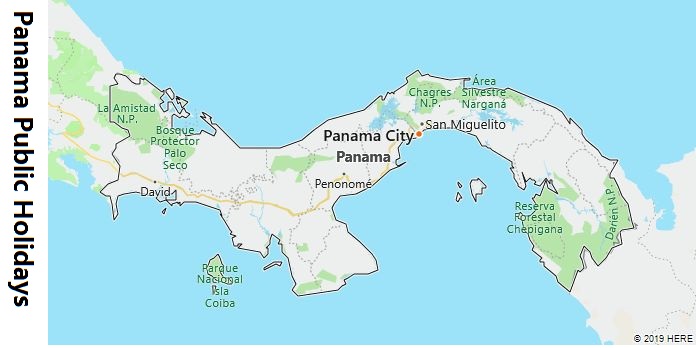Panama Holidays
Panama Public Holidays
Searching for the national holidays in Panama? All public holidays in Panama are treated like Sundays. This means that most of the Panama employees have a day off and all schools are closed on these office holidays. If you are planning a trip to Panama and want to know what the national and regional holidays are, check the details in the tables below.
List of Official Holidays in Panama for Year 2020
| # | Date | Holiday | Day |
| 1 | January 01, 2020 | New Year’s Day | Wednesday |
| 2 | January 09, 2020 | Martyr’s Day | Thursday |
| 3 | February 24, 2020 | Carnival Monday | Monday |
| 4 | February 25, 2020 | Mardi Gras | Tuesday |
| 5 | February 26, 2020 | Ash Wednesday | Wednesday |
| 6 | April 10, 2020 | Holy Friday | Friday |
| 7 | May 01, 2020 | Labor Day | Friday |
| 8 | November 03, 2020 | Separation Day | Tuesday |
| 9 | November 04, 2020 | Flag Day | Wednesday |
| 10 | November 05, 2020 | Colon Day | Thursday |
| 11 | November 10, 2020 | Los Santos Uprising Day | Tuesday |
| 12 | November 28, 2020 | Independence Day | Saturday |
| 13 | December 08, 2020 | Panama Mother’s Day | Tuesday |
| 14 | December 25, 2020 | Christmas Day | Friday |
List of Official Holidays in Panama for Year 2021
| # | Date | Holiday | Day |
| 1 | January 01, 2021 | New Year’s Day | Friday |
| 2 | January 09, 2021 | Martyr’s Day | Saturday |
| 3 | February 15, 2021 | Carnival Monday | Monday |
| 4 | February 16, 2021 | Mardi Gras | Tuesday |
| 5 | February 17, 2021 | Ash Wednesday | Wednesday |
| 6 | April 02, 2021 | Holy Friday | Friday |
| 7 | May 01, 2021 | Labor Day | Saturday |
| 8 | November 03, 2021 | Separation Day | Wednesday |
| 9 | November 04, 2021 | Flag Day | Thursday |
| 10 | November 05, 2021 | Colon Day | Friday |
| 11 | November 10, 2021 | Los Santos Uprising Day | Wednesday |
| 12 | November 28, 2021 | Independence Day | Sunday |
| 13 | November 29, 2021 | Independence Day (in lieu) | Monday |
| 14 | December 08, 2021 | Panama Mother’s Day | Wednesday |
| 15 | December 25, 2021 | Christmas Day | Saturday |















































